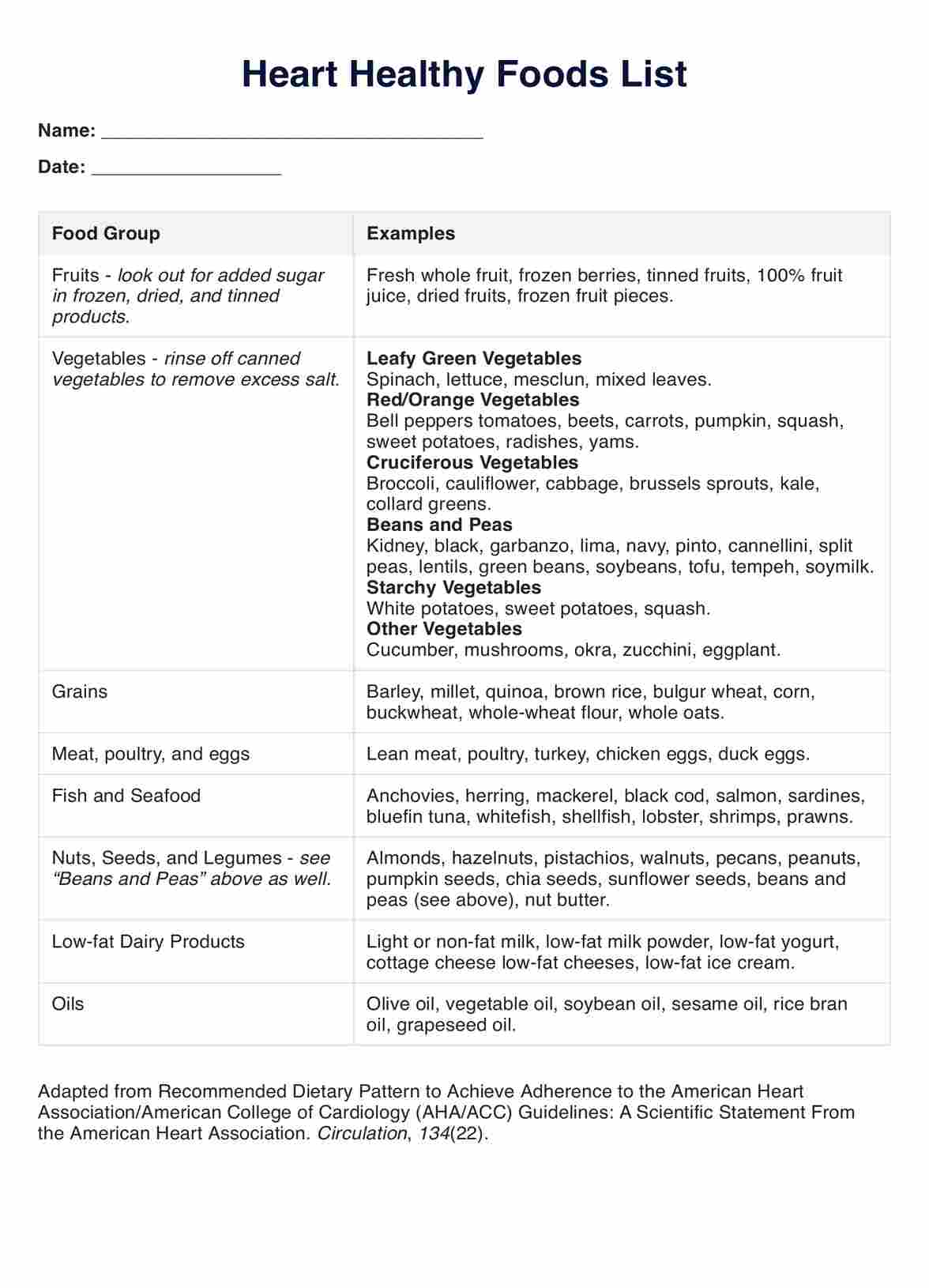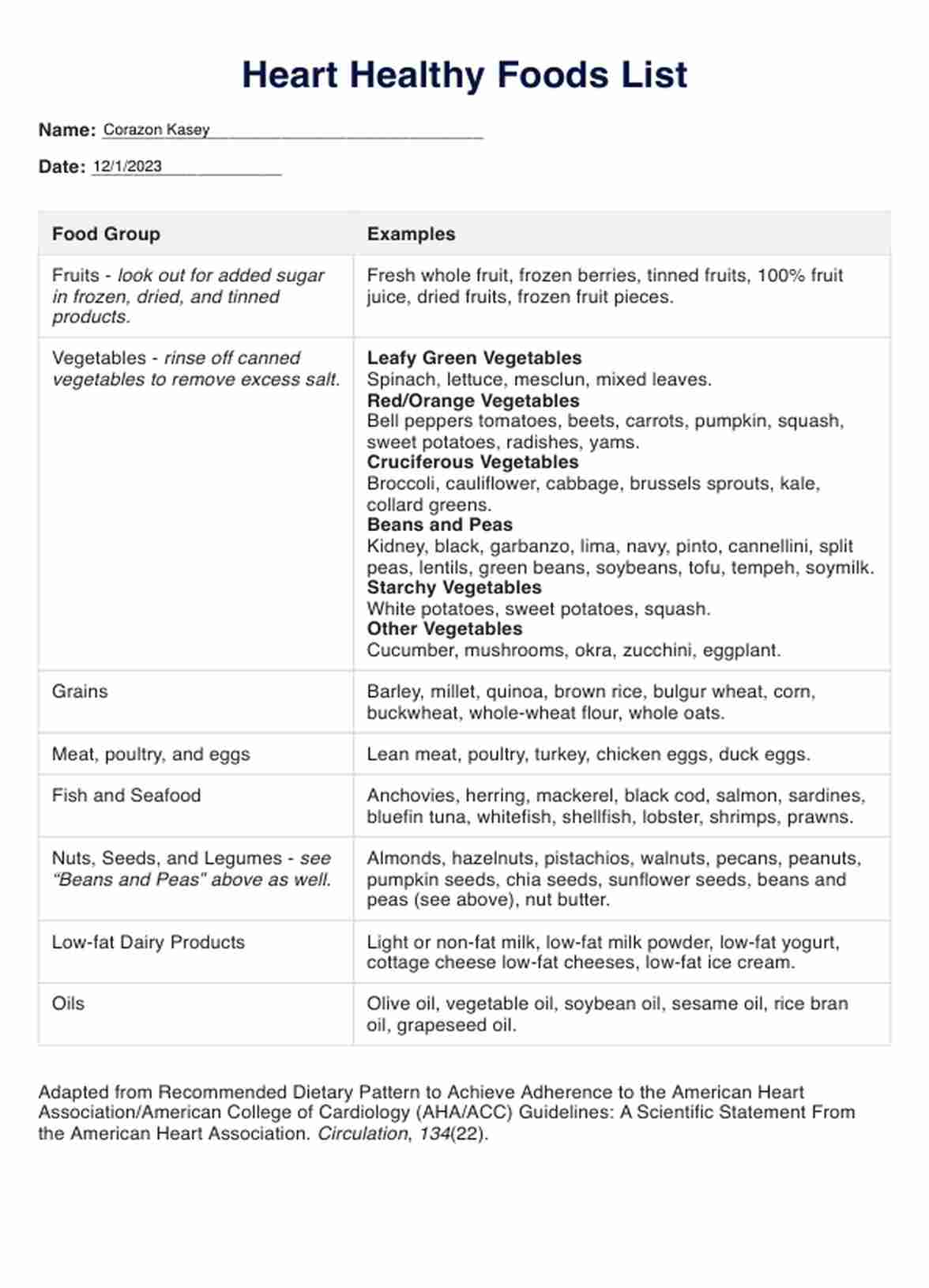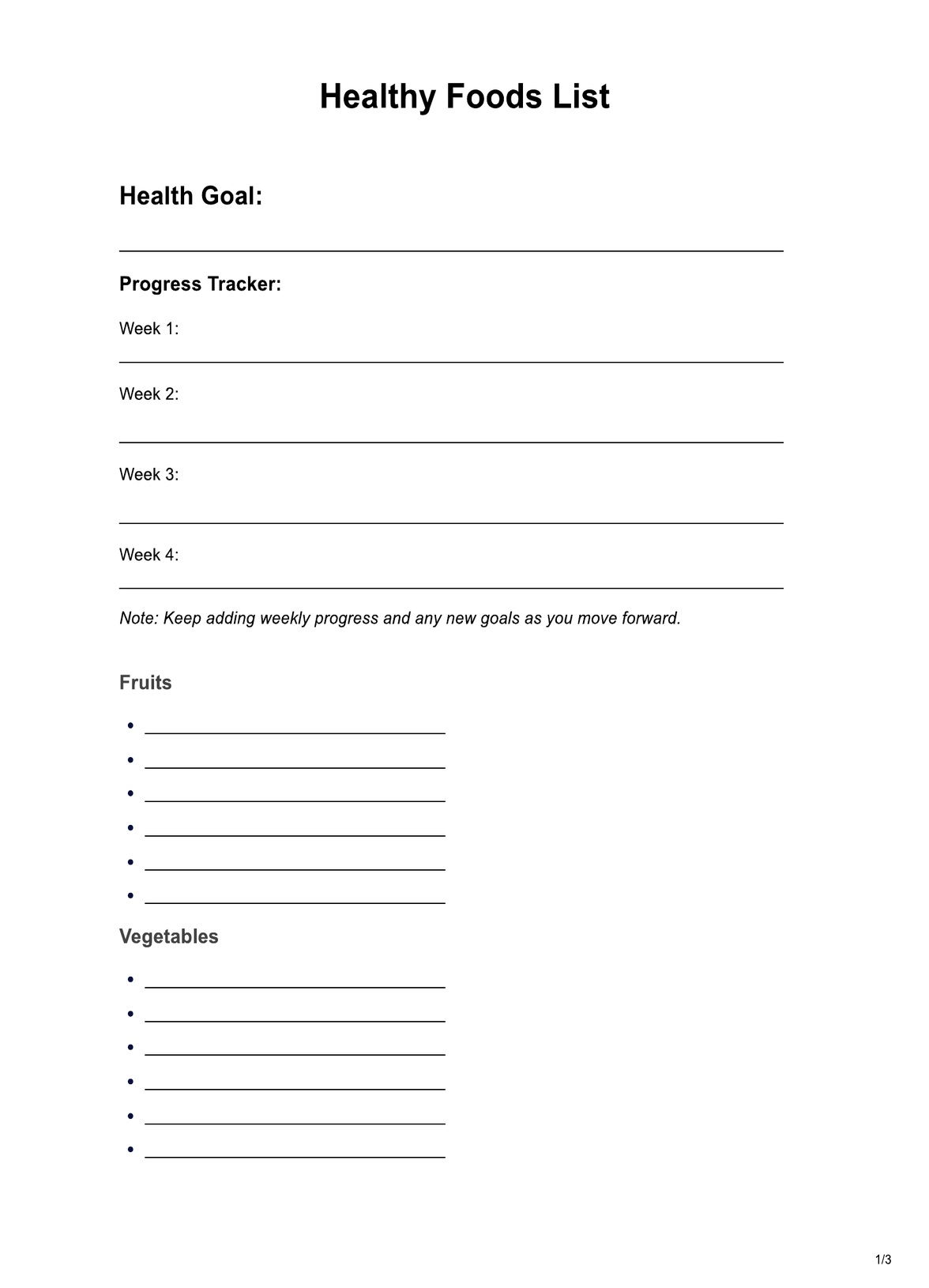Heart Healthy Foods
Reinforce heart-healthy choices for your patients with our printable Heart-Healthy Foods List.


What Is a Heart Healthy Foods List?
A Heart Healthy Foods List is a helpful resource for meal planning or inspiration while adhering to the American Heart Association’s dietary guidelines for cardiovascular health. This list includes a handy checklist, making it easy to double as a shopping list or check how many heart-healthy foods you can incorporate into your diet in a given period.
There are so many ways a heart-healthy food list can help with maintaining a balanced diet, so just keep reading to see how you can improve your cardiovascular health through food!
While this list can help you make healthy food choices, it’s important to remember that there are many other ways to improve cardiovascular health, such as limiting sodium and solid fats, quitting smoking, or living an active lifestyle.
As such, this Heart Healthy Foods List can serve as a great starting point, but there are many other factors to consider when considering heart health.
Heart Healthy Foods Template
Heart Healthy Foods Example
How Does It Work?
Instead of focusing on broad food groups, this printable heart-healthy list gives specific examples of heart-healthy foods within each food subcategory. This can be helpful when you’re at a loss for what to prepare or just can’t remember which foods to focus on for a heart-healthy diet.
Step One. Select Foods From Each Food Subcategory
We have provided a table of heart-healthy foods based on the American Heart Association and American College of Cardiology Guidelines. Still, selecting which foods suit your dietary requirements and preferences is up to you.
Step Two. Add Foods to the Attached Shopping List
Aiming to choose foods from every subgroup, add your favorites to the attached shopping list in the spaces provided.
Step Three. Go Shopping!
Now you will have a balanced and heart-healthy checklist of foods; the last step is to go grocery shopping and get cooking! Alternatively, this list can also be used as a weekly eating goals list, and each item can be ticked off as you use it in a meal throughout the week.
When Would You Use This List?
Choosing a diet promoting heart health is smart for individuals seeking to reduce their coronary artery or cardiovascular disease risk. This dietary strategy is particularly beneficial for those with an increased susceptibility to heart disease, individuals searching for a scientifically endorsed healthy eating plan, or anyone dedicated to making positive lifestyle changes.
This Heart Healthy Foods List is a simple and accessible resource that facilitates adherence to a heart-healthy diet, and professionals who may find their clients benefit from this resource include:
- Dietitians
- Nutritionists
- Weight loss and health coaches
- Personal trainers
- General Practitioners
- Nurse Practitioners
Research & Evidence
It can be easy to fall into the trap of eating the same foods repeatedly or reaching for the quickest, often sodium-packed option in a pinch, but research shows that various vegetables and plant-based protein sources are critical to achieving the best possible health outcomes. To understand why this is the case, look at each food subcategory in this Heart-Healthy Foods List.
Fruit and Vegetables
It should come as no surprise that the first two food subgroups in this Heart Healthy Foods List are fruits and vegetables. A wealth of research supports the inclusion of fruits and vegetables in a heart-healthy diet, but you may have yet to learn that these can be fresh, frozen, dried, or canned (Van Horn et al., 2016).
Leafy Green Vegetables
Blekkenhorst et al. (2018) systematically reviewed studies investigating the association between eating leafy green vegetables, such as spinach or lettuce, and cardiovascular disease. They found that the majority of studies included demonstrated a protective effect.
Hung et al. (2004) found that among US nurses, participants were 0.83 times as likely to develop cardiovascular disease for each one serving increment of leafy green vegetables. This protective effect is thought to arise from the nutrients and phytochemicals contained within leafy green vegetables, particularly dietary nitrate (Weitzberg & Lundberg, 2013).
Red/Orange Vegetables
Red and orange vegetables, such as carrots, pumpkin, or bell peppers, contain carotenoids like lutein, which have been shown to benefit cardiometabolic health (Leermakers et al., 2016).
Protein Sources
Pan et al. (2012) found that consuming red meat and processed meat increased the risk of cardiovascular mortality and that replacing one serving of red meat with one serving of fish, poultry, nuts, legumes, low-fat dairy, or whole grains reduced this mortality risk.
Seafood, particularly oily fish, is recommended one to two times a week to reduce the risk of cardiovascular diseases (Rimm et al., 2018). Plant-based protein sources such as nuts and seeds are also included in a heart-healthy diet due to their beneficial effect in reducing coronary heart disease (Satija et al., 2017). However, these should be consumed in moderation due to their caloric density.
Dairy foods provide protein, fats, essential vitamins, and minerals and have been shown to reduce the risk of major cardiovascular disease, stroke, and cardiovascular mortality (Dehghan et al., 2018).
Wholegrains
Wholegrains such as barley, millet, quinoa, corn, brown rice, or bulgur wheat are rich sources of dietary fiber. This food group has one of the largest recommended portions, with over three servings recommended per day, depending on your energy expenditure.
However, it’s not just fiber that whole grains offer, as they have also been linked with a reduced risk of coronary heart disease and a reduction in all-cause mortality (Aune et al., 2016).
From the evidence and the research-based recommendations of reputable organizations such as the American Health Association and the American College of Cardiology, it is clear that each food group is an integral part of a heart-healthy diet.
References
- Arnett, D. K., Blumenthal, R. S., Albert, M. A., Buroker, A. B., Goldberger, Z. D., Hahn, E. J., Himmelfarb, C. D., Khera, A., Lloyd-Jones, D., McEvoy, J. W., Michos, E. D., Miedema, M. D., Muñoz, D., Smith, S. C., Virani, S. S., Williams, K. A., Yeboah, J., & Ziaeian, B. (2019). 2019 ACC/AHA Guideline on the Primary Prevention of Cardiovascular Disease: A Report of the American College of Cardiology/American Heart Association Task Force on Clinical Practice Guidelines. Circulation, 140(11). https://doi.org/10.1161/CIR.0000000000000678
- Aune, D., Keum, N., Giovannucci, E., Fadnes, L. T., Boffetta, P., Greenwood, D. C., Tonstad, S., Vatten, L. J., Riboli, E., & Norat, T. (2016). Whole grain consumption and risk of cardiovascular disease, cancer, and all cause and cause specific mortality: Systematic review and dose-response meta-analysis of prospective studies. BMJ, i2716. https://doi.org/10.1136/bmj.i2716
- Bittner, V. (2020). The New 2019 AHA/ACC Guideline on the Primary Prevention of Cardiovascular Disease. Circulation, 142(25), 2402–2404. https://doi.org/10.1161/CIRCULATIONAHA.119.040625
- Blekkenhorst, L., Sim, M., Bondonno, C., Bondonno, N., Ward, N., Prince, R., Devine, A., Lewis, J., & Hodgson, J. (2018). Cardiovascular Health Benefits of Specific Vegetable Types: A Narrative Review. Nutrients, 10(5), 595. https://doi.org/10.3390/nu10050595
- Dehghan, M., Mente, A., Rangarajan, S., Sheridan, P., Mohan, V., Iqbal, R., Gupta, R., Lear, S., Wentzel-Viljoen, E., Avezum, A., Lopez-Jaramillo, P., Mony, P., Varma, R. P., Kumar, R., Chifamba, J., Alhabib, K. F., Mohammadifard, N., Oguz, A., Lanas, F., … Yusuf, S. (2018). Association of dairy intake with cardiovascular disease and mortality in 21 countries from five continents (PURE): A prospective cohort study. The Lancet, 392(10161), 2288–2297. https://doi.org/10.1016/S0140-6736(18)31812-9
- Kim, H., Caulfield, L. E., & Rebholz, C. M. (2018). Healthy Plant-Based Diets Are Associated with Lower Risk of All-Cause Mortality in US Adults. The Journal of Nutrition, 148(4), 624–631. https://doi.org/10.1093/jn/nxy019
- Leermakers, E. T., Darweesh, S. K., Baena, C. P., Moreira, E. M., Melo Van Lent, D., Tielemans, M. J., Muka, T., Vitezova, A., Chowdhury, R., Bramer, W. M., Kiefte-de Jong, J. C., Felix, J. F., & Franco, O. H. (2016). The effects of lutein on cardiometabolic health across the life course: A systematic review and meta-analysis. The American Journal of Clinical Nutrition, 103(2), 481–494. https://doi.org/10.3945/ajcn.115.120931
- Pan, A., Sun, Q., Bernstein, A. M., Schulze, Matthias B., Manson, J. E., Stampfer, M. J., Willett, W., & Hu, F. B. (2012). Red Meat Consumption and Mortality: Results From 2 Prospective Cohort Studies. Archives of Internal Medicine, 172(7), 555. https://doi.org/10.1001/archinternmed.2011.2287
- Rimm, E. B., Appel, L. J., Chiuve, S. E., Djoussé, L., Engler, M. B., Kris-Etherton, P. M., Mozaffarian, D., Siscovick, D. S., Lichtenstein, A. H., & On behalf of the American Heart Association Nutrition Committee of the Council on Lifestyle and Cardiometabolic Health; Council on Epidemiology and Prevention; Council on Cardiovascular Disease in the Young; Council on Cardiovascular and Stroke Nursing; and Council on Clinical Cardiology. (2018). Seafood Long-Chain n-3 Polyunsaturated Fatty Acids and Cardiovascular Disease: A Science Advisory From the American Heart Association. Circulation, 138(1). https://doi.org/10.1161/CIR.0000000000000574
- Satija, A., Bhupathiraju, S. N., Spiegelman, D., Chiuve, S. E., Manson, J. E., Willett, W., Rexrode, K. M., Rimm, E. B., & Hu, F. B. (2017). Healthful and Unhealthful Plant-Based Diets and the Risk of Coronary Heart Disease in U.S. Adults. Journal of the American College of Cardiology, 70(4), 411–422. https://doi.org/10.1016/j.jacc.2017.05.047
- Tharrey, M., Mariotti, F., Mashchak, A., Barbillon, P., Delattre, M., & Fraser, G. E. (2018). Plant and animal protein intake patterns are strongly associated with cardiovascular mortality: The Adventist Health Study-2 cohort. International Journal of Epidemiology, 47(5), 1603–1612. https://doi.org/10.1093/ije/dyy030
- Van Horn, L., Carson, J. A. S., Appel, L. J., Burke, L. E., Economos, C., Karmally, W., Lancaster, K., Lichtenstein, A. H., Johnson, R. K., Thomas, R. J., Vos, M., Wylie-Rosett, J., & Kris-Etherton, P. (2016). Recommended Dietary Pattern to Achieve Adherence to the American Heart Association/American College of Cardiology (AHA/ACC) Guidelines: A Scientific Statement From the American Heart Association. Circulation, 134(22). https://doi.org/10.1161/CIR.0000000000000462
- Weitzberg, E., & Lundberg, J. O. (2013). Novel Aspects of Dietary Nitrate and Human Health. Annual Review of Nutrition, 33(1), 129–159. https://doi.org/10.1146/annurev-nutr-071812-161159
Commonly asked questions
We all have times when we just don’t have inspiration for meal planning or when it seems like the only quick option is an unhealthy one. This Heart Healthy Food List is designed to present a wide range of healthy options in one easy-to-see resource to help spark healthy choices every time it’s opened.
A heart-healthy food list is used as a guide for which foods can help contribute to better heart health. It can be used for meal planning at the start of the week, as a shopping list, or as a checklist for which foods to try to eat that week.
Once you’ve used this Heart Healthy Foods List for a few weeks, you’ll likely have a better idea of which foods to choose for a heart-healthy diet. As such, this list can be used in the early stages of making a positive lifestyle change to help build healthy habits. Once the habit of choosing heart-healthy foods is solidified, you may not need to refer to the list as often.














































































































